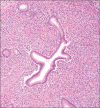Recent advances in the diagnosis and management of autoimmune pancreatitis: similarities and differences in Japan and Korea
- PMID: 23898377
- PMCID: PMC3724025
- DOI: 10.5009/gnl.2013.7.4.394
Recent advances in the diagnosis and management of autoimmune pancreatitis: similarities and differences in Japan and Korea
Abstract
Two subtypes (types 1 and 2) of autoimmune pancreatitis (AIP) are currently recognized. Type 1 AIP is related to immunoglobulin G4 (lymphoplasmacytic sclerosing pancreatitis), and type 2 AIP is characterized by neutrophilic infiltration into the epithelium of the pancreatic duct (idiopathic duct-centric pancreatitis). Although type 2 AIP is sometimes observed in the United States and Europe, most cases of AIP in Japan and Korea are type 1. The international consensus diagnostic criteria for AIP were created to be applicable worldwide and to distinguish between the two types of AIP. AIP is diagnosed based on the presence of at least one of the five cardinal features (i.e., imaging, serology, other organ involvement, histology, and response to steroid therapy). Oral steroids are the standard therapy for AIP, but immunomodulatory drugs or rituximab have been successfully used for patients with relapsed AIP in the United States and Europe. Generally, the clinical manifestations and demography of AIP are similar between Japan and Korea. However, there are differences in some aspects of the disease, including the proportion of other organ involvement, the prevalence of type 2 AIP, diagnostic criteria and maintenance therapy between the two countries.
Keywords: Immunoglobulin G; Pancreatitis; Steroids.
Conflict of interest statement
No potential conflict of interest relevant to this article was reported.
Figures
References
-
- Kamisawa T, Funata N, Hayashi Y, et al. A new clinicopathological entity of IgG4-related autoimmune disease. J Gastroenterol. 2003;38:982–984. - PubMed
-
- Yoshida K, Toki F, Takeuchi T, Watanabe S, Shiratori K, Hayashi N. Chronic pancreatitis caused by an autoimmune abnormality. Proposal of the concept of autoimmune pancreatitis. Dig Dis Sci. 1995;40:1561–1568. - PubMed
-
- Members of the Criteria Committee for Autoimmune Pancreatitis of the Japan Pancreas Society. Diagnostic criteria for autoimmune pancreatitis by the Japan Pancreas Society. J Jpn Pancreas Soc. 2002;17:585–587.
-
- Pearson RK, Longnecker DS, Chari ST, et al. Controversies in clinical pancreatology: autoimmune pancreatitis: does it exist? Pancreas. 2003;27:1–13. - PubMed
LinkOut - more resources
Full Text Sources
Other Literature Sources
Miscellaneous



